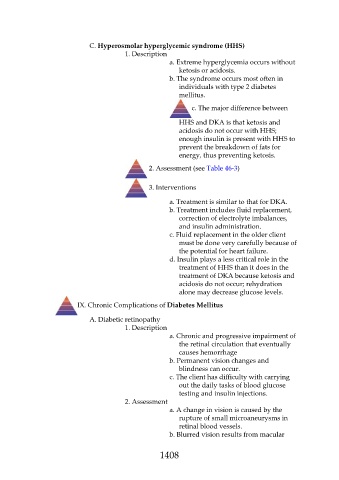Page 1408 - Saunders Comprehensive Review For NCLEX-RN
P. 1408
C. Hyperosmolar hyperglycemic syndrome (HHS)
1. Description
a. Extreme hyperglycemia occurs without
ketosis or acidosis.
b. The syndrome occurs most often in
individuals with type 2 diabetes
mellitus.
c. The major difference between
HHS and DKA is that ketosis and
acidosis do not occur with HHS;
enough insulin is present with HHS to
prevent the breakdown of fats for
energy, thus preventing ketosis.
2. Assessment (see Table 46-3)
3. Interventions
a. Treatment is similar to that for DKA.
b. Treatment includes fluid replacement,
correction of electrolyte imbalances,
and insulin administration.
c. Fluid replacement in the older client
must be done very carefully because of
the potential for heart failure.
d. Insulin plays a less critical role in the
treatment of HHS than it does in the
treatment of DKA because ketosis and
acidosis do not occur; rehydration
alone may decrease glucose levels.
IX. Chronic Complications of Diabetes Mellitus
A. Diabetic retinopathy
1. Description
a. Chronic and progressive impairment of
the retinal circulation that eventually
causes hemorrhage
b. Permanent vision changes and
blindness can occur.
c. The client has difficulty with carrying
out the daily tasks of blood glucose
testing and insulin injections.
2. Assessment
a. A change in vision is caused by the
rupture of small microaneurysms in
retinal blood vessels.
b. Blurred vision results from macular
1408

